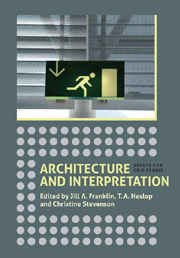Book contents
- Frontmatter
- Contents
- List of Illustrations
- Preface: In Appreciation
- List of contributors
- 1 Introduction
- Incitements to Interpret in Late Antique and Medieval Architecture
- 16 Believing is Seeing: The Natural Image in Late Antiquity
- 42 Articulation as an Expression of Function in Romanesque Architecture
- 60 Barrel-Vaulted Churches in Late Medieval Scotland
- 78 Augustinian and Other Canons' Churches in Romanesque Europe: The Significance of the Aisleless Cruciform Plan
- 99 Towers and Radiating Chapels in Romanesque Architectural Iconography
- 111 Diffusion, Imitation and Evolution: The Uncertain Origins of ‘Beakhead’ Ornament
- 128 Architecture and Pattern: The Western Façade of Lincoln Cathedral and Modernist Reference Points for its Interpretation
- Authors and Intentions
- Architecture beyond Building
- Index
16 - Believing is Seeing: The Natural Image in Late Antiquity
from Incitements to Interpret in Late Antique and Medieval Architecture
Published online by Cambridge University Press: 05 April 2013
- Frontmatter
- Contents
- List of Illustrations
- Preface: In Appreciation
- List of contributors
- 1 Introduction
- Incitements to Interpret in Late Antique and Medieval Architecture
- 16 Believing is Seeing: The Natural Image in Late Antiquity
- 42 Articulation as an Expression of Function in Romanesque Architecture
- 60 Barrel-Vaulted Churches in Late Medieval Scotland
- 78 Augustinian and Other Canons' Churches in Romanesque Europe: The Significance of the Aisleless Cruciform Plan
- 99 Towers and Radiating Chapels in Romanesque Architectural Iconography
- 111 Diffusion, Imitation and Evolution: The Uncertain Origins of ‘Beakhead’ Ornament
- 128 Architecture and Pattern: The Western Façade of Lincoln Cathedral and Modernist Reference Points for its Interpretation
- Authors and Intentions
- Architecture beyond Building
- Index
Summary
ERIC, it seems to me, has always harboured an inclination to entertain a bold thesis, to venture down a potentially stimulating path of speculative inquiry, as long as he has felt reasonably sure of his ground – the ingenious paper in which he reframed our vision of that Mona Lisa of prehistoric architecture, Stonehenge, comes immediately to mind. I want to take this sense as licence for offering him the following essay, a token of long friendship and admiration. The argument is founded in large part on the evidence of curiously configured columns, and this seems most apposite, since Eric has done as much as anyone to draw our attention to the ways in which peculiarly ornate columns and piers were deployed in medieval churches to embellish, articulate and dramatize liturgical space.
Ways of seeing
The present paper is concerned with the polished marble columns and veneers with which élite churches were fitted out in late antiquity, with certain aspects of the striking configurations of veining on their highly finished surfaces, and with the ways in which contemporaries saw and understood these features. In its main drift it complements and responds to three studies which have variously addressed these issues, although it was fully developed before I became aware of the last two essays.
- Type
- Chapter
- Information
- Architecture and InterpretationEssays for Eric Fernie, pp. 16 - 41Publisher: Boydell & BrewerPrint publication year: 2012



